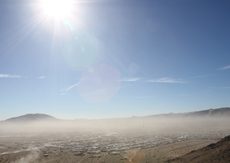 Washington, DC – The California Motorized Recreation Council (CMRC), an umbrella group of the eight largest OHV access groups in California, has agreed to contract terms with the Livingston Group, LLC in Washington, DC to help stave off the expansion of the 29 Palms Marine Base. The move comes on the heels of the expected April 27th, 2012 release of a Final Environmental Impact Study (FEIS) by the Marine Corps. The Marine Corps wishes to annex approximately 160,000 acres of the Johnson Valley Off-Highway Vehicle area, which is the largest open OHV area in the United States and contributes over $70 million dollars into the economy of the surrounding High Desert communities annually.
Washington, DC – The California Motorized Recreation Council (CMRC), an umbrella group of the eight largest OHV access groups in California, has agreed to contract terms with the Livingston Group, LLC in Washington, DC to help stave off the expansion of the 29 Palms Marine Base. The move comes on the heels of the expected April 27th, 2012 release of a Final Environmental Impact Study (FEIS) by the Marine Corps. The Marine Corps wishes to annex approximately 160,000 acres of the Johnson Valley Off-Highway Vehicle area, which is the largest open OHV area in the United States and contributes over $70 million dollars into the economy of the surrounding High Desert communities annually.
The Marine Corps proposal would limit motorized recreation to less than one percent of the entire California Desert, a move in which the Off-Road Business Association (ORBA) contends will cripple the already battered off-road manufacturing industry, and increase the likelihood of resource damage and safety concerns at the remaining OHV areas. “Our industry has continued to grow at steady pace since the late 1970s, while in that same time period we have lost 48% of the recreational opportunities in the California Desert.” Fred Wiley, the president of the Off-Road Business Association went on to say, “While we support the training needs of our military, it is a bitter pill to swallow losing such a massive piece of our public lands, considering the limited time the Marine Corps plans to utilize this portion of the desert.”
According to a draft EIS, the Marine Corps only plans to hold training exercises 24 days each year in Johnson Valley. While the expected proposal does allow for a limited shared use of a portion of the OHV area, event promoter Dave Cole, who produces a large off road race in Johnson Valley, believes, ” The current shared use alternative has no language for securing the perimeter of the expansion, and that’s a set up for a dangerous situation for the public. They don’t currently secure the base line now, and most of the public has no idea they are wandering on to the base. It will be 10 times worse if they expand.”
“Our primary objective was to figure out a way in which everyone could get what they needed. Rather than draw a line in the sand, we are proposing the Marine Corps work with us to meet those needs. To accomplish our goals, we had to pass our message to professionals in DC, and that’s where the Livingston Group comes in.” Jerry Grabow, American Motorcyclists Association District 37 Off-Road President, went on to say, “It’s a departure from our normal way of dealing with the loss of OHV recreation opportunities.”
Unifying a diverse group of OHV enthusiasts from across the state, CMRC delegates voted overwhelmingly to support the contract with the Livingston Group. The move supports a re-enforced position by off-roaders who are willing to go all the way to Washington, DC to maintain motorized recreation in Johnson Valley. A strategy that hopefully provides for future generations to experience the last great expanse of desert that OHV users may enjoy.
There are a number of issues that will need to be addressed if the Marines wish to push forward with their expansion into Johnson Valley, among them the demonstration of need. With tremendous budget cuts looming for our armed forces, there remains a question of weather the Marine Corps can even afford to assemble the troops they hope to train in the new expansion area, and then there is the changing mission of the Marine Corps that appears to be a return to their amphibious roots. The 29 Palms Marine base currently claims title of the second largest military base in the world, and presently resembles the sheer size of ¾ the state of Rhode Island. Only the neighboring Fort Irwin Army base is larger, which is located only miles away.
Late news addition The Final EIS expected on April 27th is rumored, but unconfirmed delayed until May. No date has been made available.